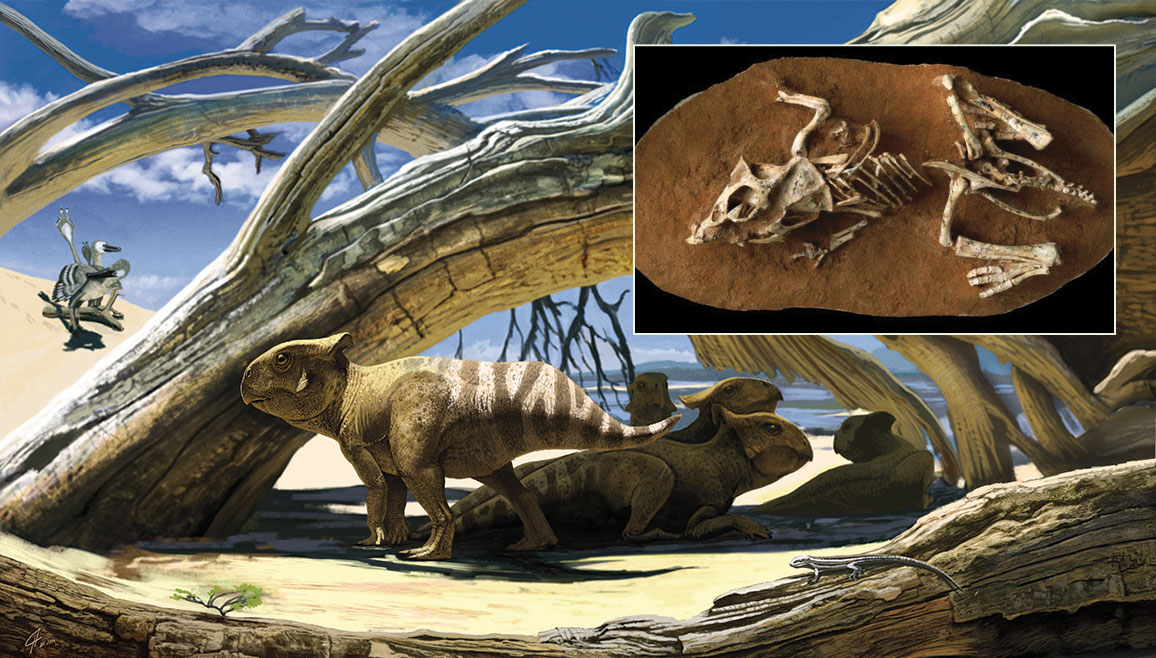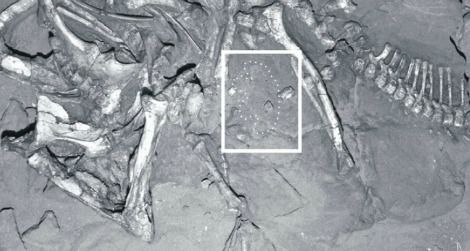An international team of paleontologists from Belgium, France and Mongolia, has unearthed an exceptional block of perinatal specimens (babies) of the giant hadrosaurid dinosaur Saurolophus angustirostris, with associated eggshell fragments, in an area called the Dragon’s Tomb.

Perinatal specimens of Saurolophus angustirostris: bones on the right side of the block show a certain degree of articulation, whereas bones on the left are disarticulated. Image credit: Dewaele L et al.
The Dragon’s Tomb dinosaur locality was discovered in 1947 in the Nemegt Formation of Mongolia’s Gobi Desert.
The bone bed at this site has yielded numerous articulated skeletons of Saurolophus angustirostris. This dinosaur is particularly abundant in the whole Nemegt Formation, comprising approximately 20 percent of all vertebrate fossils found.

In a new report published in the journal PLoS ONE, paleontologists describe three or four perinatal specimens of Saurolophus angustirostris and two associated eggshell fragments.
The young dinosaurs were likely part of a nest originally located on a river sandbank. The skull length of these Saurolophus angustirostris was around 5 percent that of the largest known S. angustirostris specimens, indicating that these specimens were in the earliest development stages.
“The perinatal bones already resembled Saurolophus angustirostris characteristics, including the upwardly directed snout,” the paleontologists explained.

“The specimens did not yet have the characteristic cranial crest at the top of the head and areas of the skull-the cervical neural arches-were not yet fused, which suggest they may be in the earliest stages of the development of S. angustirostris.”
“The poorly developed crest in Saurolophus angustirostris babies provides evidence of ontogenetic crest growth within the Saurolophini tribe,” said lead author Dr Leonard Dewaele, of Ghent University and the Royal Belgian Institute of Natural Sciences.
“The Saurolophini are the only Saurolophinae to bear supra cranial crests as adults.”

Adult Saurolophus angustirostris. Image credit: L. Xing & Y. Liu, doi: 10.1371/journal.pone.0031295.g013.
The paleontologists can’t tell whether Saurolophus angustirostris babies were still in the eggs or had just hatched when they died, but they were apparently already dead and partly decomposed when they were buried by river sediment during the wet summer season.

The fossilized eggshell fragments associated with the perinatal individuals closely resemble those found from Saurolophus angustirostris relatives in Mongolia.
Source: sci.news








